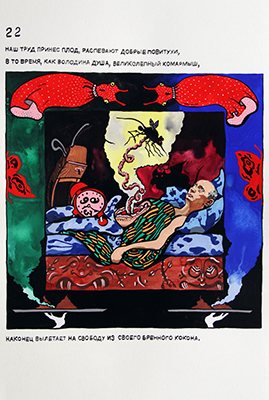Roee Rosen is a painter, filmmaker, and writer whose work interrogates structures of power, trauma, and evil. His often grotesque, macabre, and obscene works evoke a sense of realism in the face of the structural violence of a world where victims turn perpetrators and terror bears the name of the rule of law.
In Vladimir’s Night, Vladimir Putin is shown vacationing in his summer mansion—in the role of a little child. Before falling asleep he imagines seeing faces in the wooden veneer of his bedroom cabinet. Animated objects flow out to cuddle with Vladimir, but the scene soon turns violent. Vladimir is gradually raped, tortured, and murdered by objects.
The author of these paintings and poems, Russian artist Efim Poplavsky (1978–2011)—aka Maxim Komar-Myshkin—is one among several fictional figures created by Roee Rosen. He was allegedly influenced by Soviet author Daniil Kharms’s funny and horrifying sense of the absurd, embodying both a defiant autonomy through art and the realism of terror. Poplavsky, who allegedly committed suicide last year, is described by Rosen as a Jewish emigrant to Israel from Russia who suffered from severe paranoia, believing that Putin himself wanted him dead. The album Vladimir’s Night is hence an act of personal revenge, which calls upon the aesthetics of Soviet children books for aid.
Roee Rosen’s other work in the exhibition is the video Out (Tse). It is both a documentary and exorcistic horror film. The film alludes to the European-Christian tradition of exorcism rituals, whereby a demon or devil is driven out of the body of a possessed person. In Out, two people from the Israeli BDSM (bondage and discipline / sadomasochism) scene agree to hold a role-playing session in which the spirit of extreme right-wing Israeli foreign minister Avigdor Lieberman is exorcised, using as text original quotes by Lieberman. Out is a piece on domination, submission, and the acting out of power structures. But above all, it is an anatomy of borderline-disorders—the projection of one’s own fears onto others that marks the structural core of xenophobia and racism.
Roee Rosen, born 1963 in Israel, lives and works in Tel Aviv-Yafo

